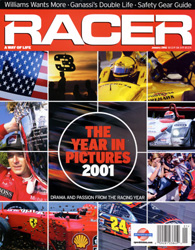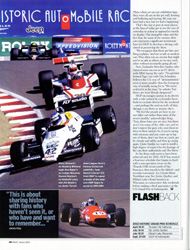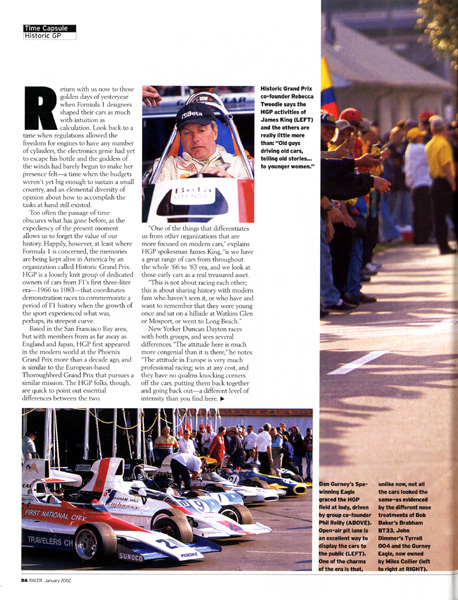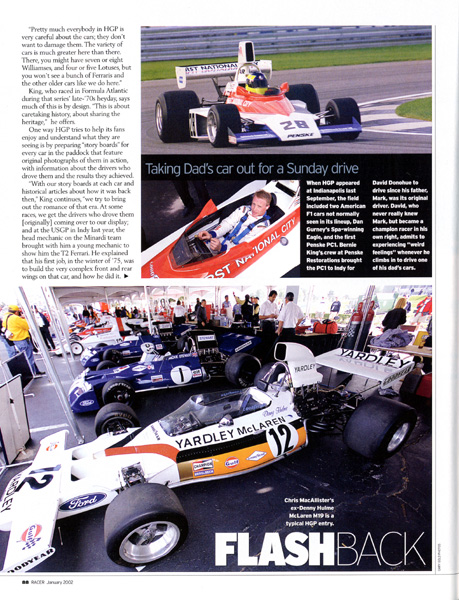




FLASHBACK
Opening up the memory banks with a rolling museum of Grand Prix history
By John Zimmermann
Return with us now to those golden days of yesteryear when Formula 1 designers shaped their cars as much with intuition as calculation. Look back to a time when regulations allowed the freedom for engines to have any number of cylinders, the electronics genie had yet to escape his bottle and the goddess of the winds had barely begun to make her presence felt -- a time when the budgets weren't yet big enough to sustain a small country, and an elemental diversity of opinion about how to accomplish the tasks at hand still existed.
Too often the passage of time obscures what has gone before, as the expediency of the present moment allows us to forget the value of our history. Happily, however, at least where Formula 1 is concerned, the memories are being kept alive in America by an organization called Historic Grand Prix. HGP is a loosely knit group of dedicated owners of cars from F1's first three-liter era--1966 to 1983 -- that coordinates demonstration races to commemorate a period of F1 history when the growth of the sport experienced what was, perhaps, its steepest curve.
Based in the San Francisco Bay area, but with members from as far away as England and Japan, HGP first appeared in the modern world at the Phoenix Grand Prix more than a decade ago, and is similar to the European-based Thoroughbred Grand Prix that pursues a similar mission. The HGP folks, though, are quick to point out essential differences between the two.
"One of the things that differentiates us from other organizations that are more focused on modern cars," explains HGP spokesman James King, "is we have a great range of cars from throughout the whole '66 to '83 era, and we look at those early cars as a real treasured asset.
"This is not about racing each other; this is about sharing history with modern fans who haven't seen it, or who have and want to remember that they were young once and sat on a hillside at Watkins Glen or Mosport, or went to Long Beach."
New Yorker Duncan Dayton races with both groups, and sees several differences. "The attitude here is much more congenial than it is there," he notes. "The attitude in Europe is very much professional racing; win at any cost, and they have no qualms knocking corners off the cars, putting them back together and going back out -- a different level of intensity than you find here.


CAPTIONS:
Historic Grand Prix co-founder Rebecca Tweedie says the HGP activities are little more than: "Old guys driving old cars, telling old stories... to younger women."
Dan Gurney's Spa-winning Eagle graced the HGP field at Indy, driven by group co-founder Phil Reilly (ABOVE). Open-air pit lane is an excellent way to display the cars to the public (LEFT). One of the charms of the era is that, unlike now, not all the cars looked the same -- as evidenced by the different nose treatments of Bob Baker's Brabham BT33, John Dimmer's Tyrrell 004 and the Gurney Eagle, now owned by Miles Collier (left to right at RIGHT).
SIDEBAR: Taking Dad's car out for a Sunday drive When HGP appeared at Indianapolis last September, the field included two American F1 cars not normally seen in its lineup, Dan Gurney's Spa-winning Eagle, and the first Penske PC1. Bernie King's crew at Penske Restorations brought the PC1 to Indy for David Donohue to drive since his father, Mark, was its original driver. David, who never really knew Mark, but became a champion racer in his own right, admits to experiencing "weird feelings" whenever he climbs in to drive one of his dad's cars. CAPTIONS: Chris MacAllister's ex-Denny Hulme McLaren M19 is a typical HGP entry. |
"Pretty much everybody in HGP is very careful about the cars; they don't want to damage them. The variety of cars is much greater here than there. There, you might have seven or eight Williamses, and four or five Lotuses, but you won't see a bunch of Ferraris and the other older cars like we do here." King, who raced in Formula Atlantic during that series' late-'70s heyday, says much of this is by design. "This is about caretaking history, about sharing the heritage," he offers. One way HGP tries to help its fans enjoy and understand what they are seeing is by preparing "story boards" for every car in the paddock that feature original photographs of them in action, with information about the drivers who drove them and the results they achieved. "With our story boards at each car and historical articles about how it was back then," King continues, "we try to bring out the romance of that era. At some races, we get the drivers who drove them [originally] coming over to our display; and at the USGP in Indy last year, the head mechanic on the Minardi team brought with him a young mechanic to show him the T2 Ferrari. He explained that his first job, in the winter of '75, was to build the very complex front and rear wings on that car, and how he did it. |
Then, when we ran our exhibition laps, they were all out on the pit wall, hooting and hollering and waving. We may not have had a race, but we had a happening." That's the way it goes at most places, as the fans of today get to see the cars of yesterday in action as opposed to merely on display. This intangible value and the fact that, for most of the owners, their cars represent a significant investment have led HGP to develop a driving code aimed at preserving the show. "We recognize that these are fast cars," King explains, "and not as safe as modern cars. They often run on circuits that might not be as safe as others, so we race each other without necessarily going all out." New Zealander Howden Ganley, who enjoyed some success as an F1 driver with BRM during the early '70s and later formed Tiga Cars with Tim Schenken, believes the U.S. way of "demonstration" races is more sensible than the European way of actually racing for it. "We never realized it at the time," he admits, "but these cars were bloody dangerous!" HGP encourages caution in its drivers with a rule written by co-founder Steve Earle to exclude drivers for the weekend -- and perhaps the next as well -- if they damage a car, theirs or anyone else's. "We feel the people are here to see our older cars rather than some of the newer models," acknowledges King. "Sure, those later cars are nice; but there aren't too many of the older cars, and we don't expect the guys who own them to drive in their mirrors. So, if you're racing with someone and you come up to lap one of them, don't use him as a pick; get by cleanly and safely, and then go racing again. Quite frankly, we want to instill a high degree of respect for the heritage of the cars, their authenticity and The Show." So far, those ends seem to have been achieved and, for 2002, HGP has created a four-race schedule that begins in April with a non-spectator event on the Thunder Hill circuit north of San Francisco, then travels to the fabled -- and recently renovated -- Le Circuit Mont Tremblant near Ste. Jovite, Quebec, and Elkhart Lake's Road America in Wisconsin on consecutive July weekends before making a third appearance at the U.S. Grand Prix in Indianapolis. 2002 Historic Grand Prix Schedule April 19-21Thunder Hill, California |

CAPTIONS: Steve Romack's ex-Rosberg Williams leads Dan Baker's ex-Lunger McLaren, Duncan Dayton's ex-Andretti Lotus and Jim Busby's ex-Jarier Tyrrell down Laguna Seca's famous Corkscrew (ABOVE). Todd Morici's Ferrari 312 from 1967 is a good example of the older cars HGP hopes to preserve (BELOW). "This is about sharing history with fans who haven't seen it, or who have and want to remember..." James King |

